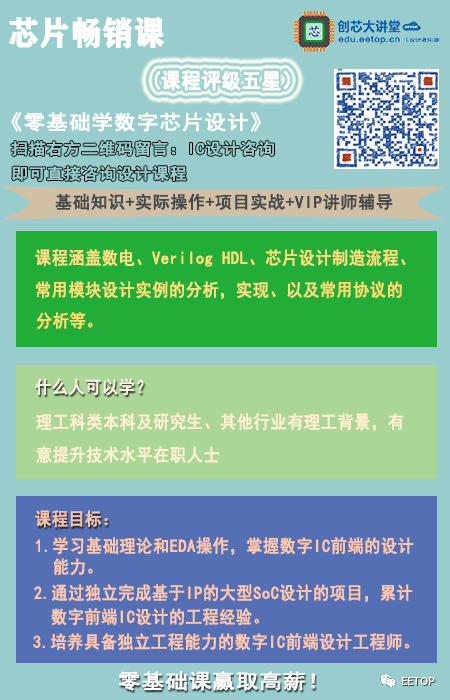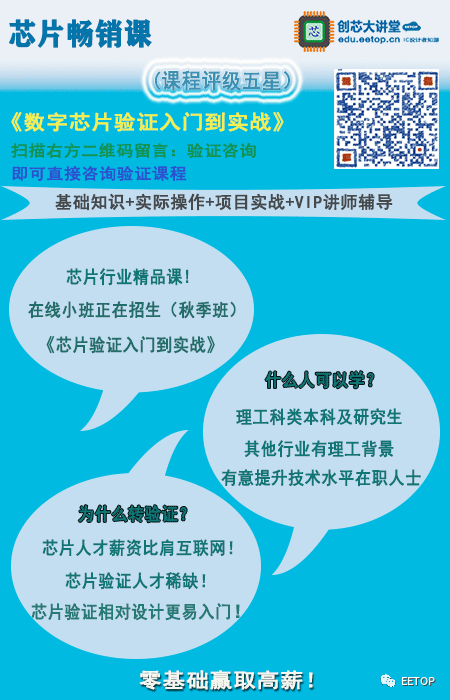Welcome to the Chip Talent Network to search for chip talents and positions.
Source: EETOP compiled from allaboutcircuits
What Is A Communication Protocol?
Over time, computing has evolved from standalone systems to computers connected to form networks (Figure 1).

Figure 1. A simplified diagram of connected computers in a Local Area Network (LAN).
Communication networks support shared computing, allowing many users or terminals to access the same computer system. In specific scenarios, shared computing allows a central system to handle primary tasks and distribute its results to multiple users who lack that capability.
Communication networks are also used for distributed computing, where many computers can work together as peers. These networks help transmit data from one point to another.
An important point to note is that for different devices in a network to communicate or share data effectively, they must use a common language. This is where communication protocols come into play.
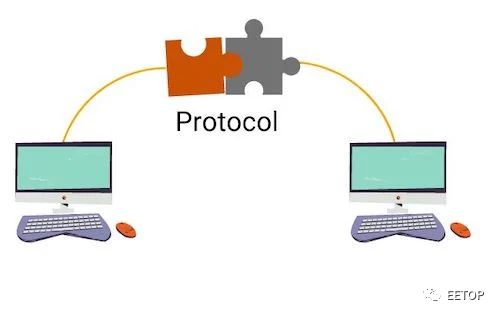
Figure 2. A conceptual view of a protocol as a common language that allows different devices to communicate.
A communication protocol is a rulebook that strictly defines how the hardware and software of devices should perform each communication function.
In a communication protocol (also known as a rulebook), you will find rules for the following:
-
How devices should identify themselves -
How they should establish, maintain, and terminate connections -
What types of data they can send and how they should format it -
How they ensure data is correctly received and understood at both ends -
What modulation and channels devices should use -
What error coding techniques devices should use -
How exchanged information should be protected
Communication protocols are based on various factors, including the characteristics of the information to be exchanged, the communication medium, and the capabilities of the devices that will use it.
From Protocols to Standards
Communication protocols can become standards through a standardization process. Standards are agreed-upon or widely adopted protocols that must be followed, regardless of the manufacturer. They allow different companies producing related products to adhere to the same protocols, enabling their devices to communicate.
This is why you can connect a Bluetooth headset from one company to a phone from another. Although the manufacturers of these products are different, they all follow standardized communication protocols, in this case, Bluetooth.
In addition to Bluetooth, there are several other popular communication standards:
-
Ethernet -
Transmission Control Protocol/Internet Protocol (TCP/IP) -
Wi-Fi -
LoRa -
Low Energy Bluetooth (BLE)
Next, let’s talk about BLE.
What Is Low Energy Bluetooth?
At its core, Bluetooth is a short-range connectivity technology that uses radio waves as the communication medium. The first standard or specification of this technology is called Bluetooth Classic. Its primary design goal is to replace cables and provide wireless connectivity between mobile phones and other portable devices.
BLE was introduced as part of the Bluetooth 4.0 specification in 2010, optimized for ultra-low power applications. Due to its use in ultra-low power applications, BLE serves the market for battery-powered devices that require wireless network capabilities. Before BLE, it was challenging for these types of devices to support interconnectivity due to their high battery consumption.
Below, we will introduce some of BLE’s optimized features to achieve ultra-low power goals.
Low Energy Bluetooth Power-Saving Features
1. Wireless Transmission of BLE
Wireless transmission of BLE-enabled devices is only awakened when necessary to save power. When the device wants to send or listen for data, the LE radio turns on to quickly perform the necessary tasks and then disconnects. This operation of the LE radio is different from that of Bluetooth Classic radio, which remains on most of the time and can maintain connections for hours or days.
Since the LE radio is intermittently connected, it is suitable for applications where devices occasionally send small packets of data, ranging from once a second to once every few days. For example, a heart rate monitor in a fitness tracker can collect all heart rate data and send it to your smartphone once an hour. Or a temperature sensor, which only triggers to send temperature readings if the temperature is very high or very low.
2. Shorter Wireless Connection Time of LE
Bluetooth LE consumes less energy due to the reduced number of RF channels available for connection, resulting in faster connection speeds and less scanning time. Bluetooth Classic has 32 RF channels available for establishing connections between devices, while Bluetooth LE has only three.
Additionally, BLE devices that want to be discovered will send signals on RF37, RF38, and RF39 channels (known as the primary advertising channels).
When a device wants to find other devices, it listens for broadcast data packets on the primary broadcast channels. Since there are only three primary broadcast channels, LE wireless does not have to scan as many channels, resulting in less awake time and therefore less energy used.
3. LE Wireless Transmission Uses Smaller Packets
Bluetooth LE packets are much smaller than Bluetooth Classic packets. The smaller packet size requires less computational overhead during encoding and decoding, which also reduces power consumption.
4. Battery Discharge is Pulsed
One characteristic of batteries is that their discharge method affects their capacity. battery capacity is the amount of energy that can be extracted from the battery under specific conditions. Constant current discharge of a battery shortens its lifespan. On the other hand, pulsed discharge (where there are idle times between discharges) helps keep the battery as close to its nominal capacity as possible. This is known as the battery recovery effect.
Bluetooth LE takes advantage of this recovery effect. The data transmission using BLE is completed in periodic short bursts, followed by idle periods. During these idle periods, the battery can recover, helping to extend its lifespan.
5. Low Energy Bluetooth Protocol is Asymmetrically Designed
The LE protocol uses an asymmetric design to assign tasks to devices that want to connect. The resource-limited device does the least work. For the devices that want to connect, one must play the central role while the other plays the peripheral role. The central device usually has more processing power and battery life, such as a smartphone. In contrast, peripheral devices are generally less powerful and have limited energy resources, such as fitness trackers, heart rate monitors, etc.
Low Energy Bluetooth Protocol Stack
A protocol stack (or protocol suite or protocol architecture) is a set or group of sub-protocols that work together to achieve complete communication between two or more computers in a network. Each sub-protocol in the protocol stack is called a layer. The Bluetooth LE protocol stack uses a divide-and-conquer approach. This means that the overall communication task is divided among layers, with each protocol layer responsible for specific communication functions.
Figure 3 shows an example of a LE protocol stack and its protocol layers.
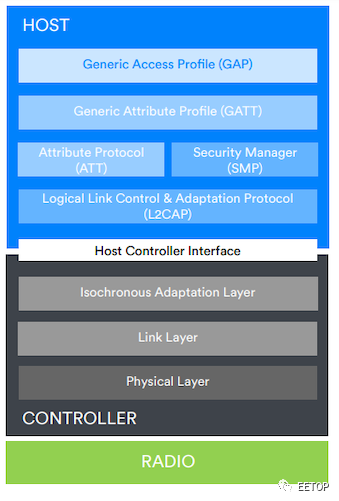
Figure 3. Low Energy Bluetooth Stack. Image provided by Bluetooth SIG
Table 1 summarizes the main functions of each layer in the LE protocol stack.
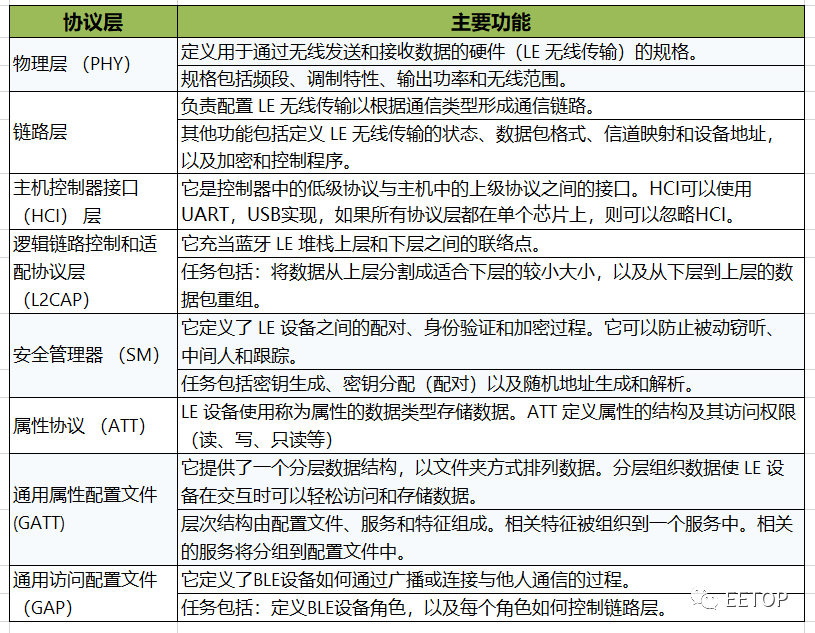
Two Main Ways of BLE Device Communication
BLE-enabled devices can communicate in one of two ways:
1. Connectionless communication: It broadcasts its data to any listening device
2. Connection-oriented communication: It forms a dedicated connection with another device and communicates with it using a client-server mechanism
Figure 4 shows an overview of these two communication methods.

Figure 4. Different Ways of BLE Device Communication. Image provided by Renesas Electronics
Connectionless Communication
LE devices that want to participate in connectionless communication are assigned two roles defined by the GAP layer. One device must be a broadcaster, and the other device must be a listener.
The GAP roles of devices control the link layer of the device, which in turn controls the LE radio of the device.
-
Step 1: The broadcasting device indicates its link layer to become a broadcaster. It controls the LE radio to transition from standby or idle state to broadcasting state and vice versa. -
Step 2: When the LE radio is in broadcasting state, (the link layer) can send broadcast data packets on the three dedicated advertising channels RF37, RF38, and RF39. Broadcast data packets can contain data such as the broadcasting device’s name and address. -
Step 3: On the other hand, the listener indicates its link layer to become a scanner. The link layer as a scanner controls the LE radio to transition from standby state (idle) to scanning state and vice versa. -
Step 4: When the LE radio is in scanning state, the scanner tunes in and listens for data on the primary broadcasting channels (RF37, RF38, and RF39).
For example, the image in Figure 5 shows my phone as a listener picking up data packets from two broadcasting beacons:
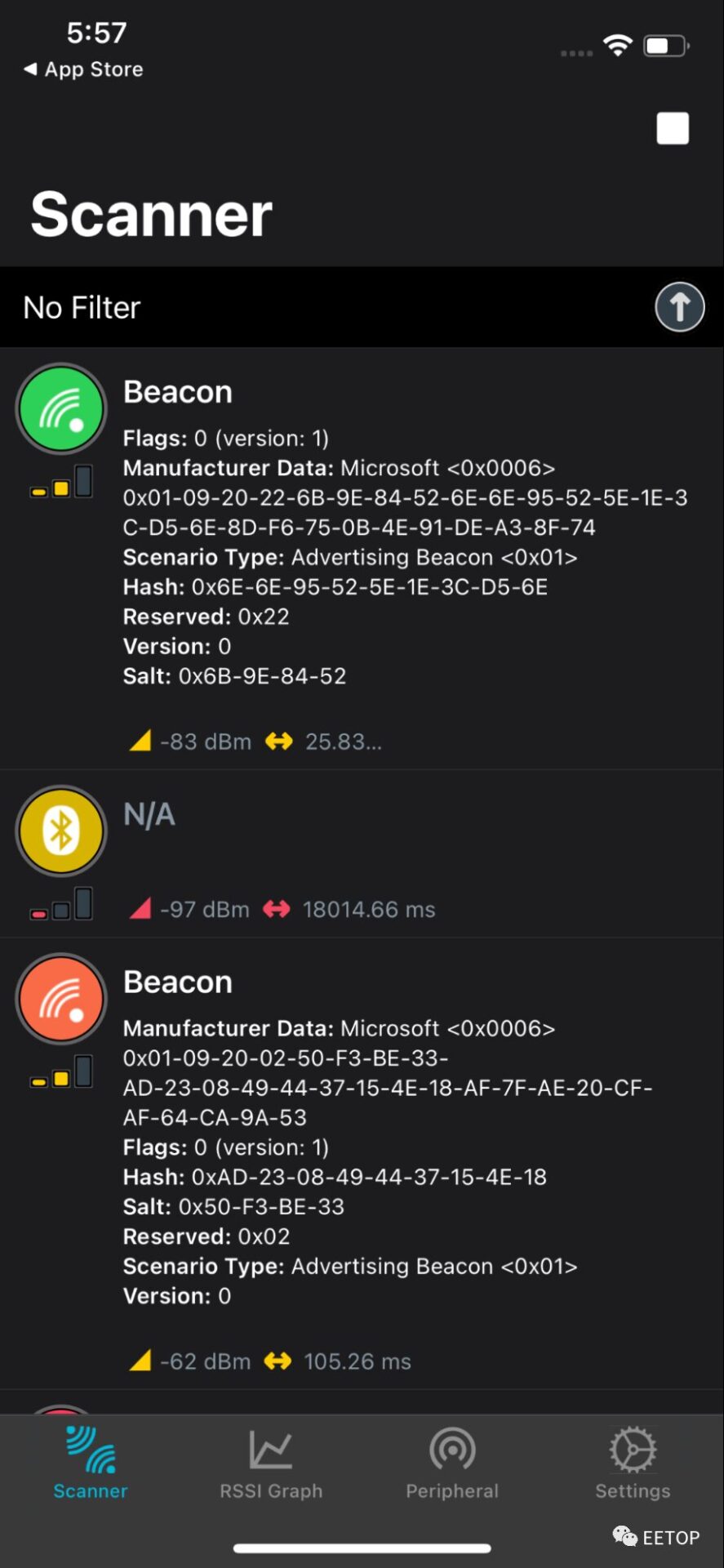
Figure 5. Picking Device.
Common applications of connectionless communication in BLE include beacons and IoT sensors broadcasting their readings.
Connection-Oriented Communication
In connection-oriented communication, you must be clear about two main concepts: device discovery and the client-server relationship between connected devices.
Device Discovery and Connection Setup
It is important to note that anything in BLE referred to as a profile can control and coordinate the other layers of the stack for specific use cases. In this regard, the GAP controls how the link layer and PHY layer (LE radio) should operate for BLE device discovery and connection establishment.
LE devices that want to participate in connection-oriented communication are assigned two roles defined by the GAP layer. One device must be the central device, and the other device must be the peripheral device..
-
Step 1: The peripheral device’s broadcast indicates that the LE radio broadcasts data packets on the advertising channel and listens for connection request data packets from the central device. -
Step 2: When the central device wants to connect to the peripheral device, it first uses its link layer as a scanner. The scanner will use the LE radio to listen for broadcast data packets. -
Step 3: When the central device identifies the device it wants to connect to, the link layer switches the LE radio from broadcasting state to initiating state. -
Step 4: In the initial state, the LE radio sends a connection request data packet to the peripheral device. If the peripheral device accepts the connection request, the connection is established.
Client-Server Relationship
Once the connection setup is complete, the Generic Attribute Profile performs three main functions: it uses the ATT protocol to construct the data to be exchanged. It defines a hierarchy of services and characteristics arranged like file folders for easy storage and access.
It also defines the client-server relationship for how connected devices interact. GATT defines two roles for connected devices: one device will be the client, and the other will be the server.
-
Server: Acts as a database that holds data variables. The server uses the attribute data types of the ATT protocol to store data. Data on the server is organized hierarchically according to GATT definitions. Data on the server can be accessed based on permissions. Some data can be both readable and writable. Some may be read-only.
-
Client: After connecting to the server, the client typically requests access to the data (attributes) stored on the server. The client can read and/or write the server’s attributes based on access permissions.
Examples of Connection-Oriented Applications for BLE Devices:
A sleep tracker with sensors can detect physiological changes that occur while we sleep. The tracker connects to your smartphone to share readings. The tracker acts as the server. The smartphone acts as the client, reading the data stored in the tracker.
Bluetooth SIG (Special Interest Group)
What is Bluetooth SIG? Bluetooth SIG is an independent nonprofit organization responsible for defining Bluetooth standards. Bluetooth SIG is not a company or a collaboration. It does not manufacture or sell Bluetooth products.
Instead, it has four main responsibilities. These are:
-
Publishing Bluetooth specifications -
Protecting the Bluetooth trademark -
Providing qualification certification programs before products hit the market -
Promoting Bluetooth technology
Bluetooth SIG was established in 1998 with only five founding members. They were Ericsson, Intel, IBM, Nokia, and Toshiba. Over the years, the Bluetooth SIG organization has grown to include over 16,000 member companies.
Bluetooth SIG offers two membership levels for companies wishing to join: adopter membership and associate membership (Table 2).
Table 2. Bluetooth SIG Member Details.
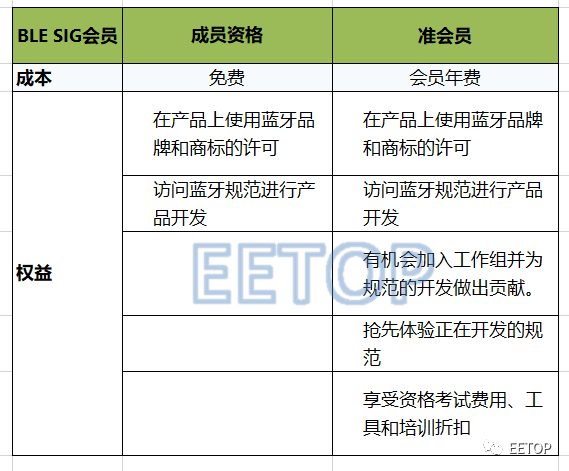
Finally, Bluetooth SIG has seven member companies with founding member status. These include all founding companies, as well as Apple and Microsoft.
Efficient Protocols and Corporate Collaboration
In our increasingly interconnected world, low energy Bluetooth has become a crucial communication technology for ultra-low power applications. As we have seen, it requires efficient protocol design and collaboration between companies to truly make BLE or any communication standard have a significant market impact.
